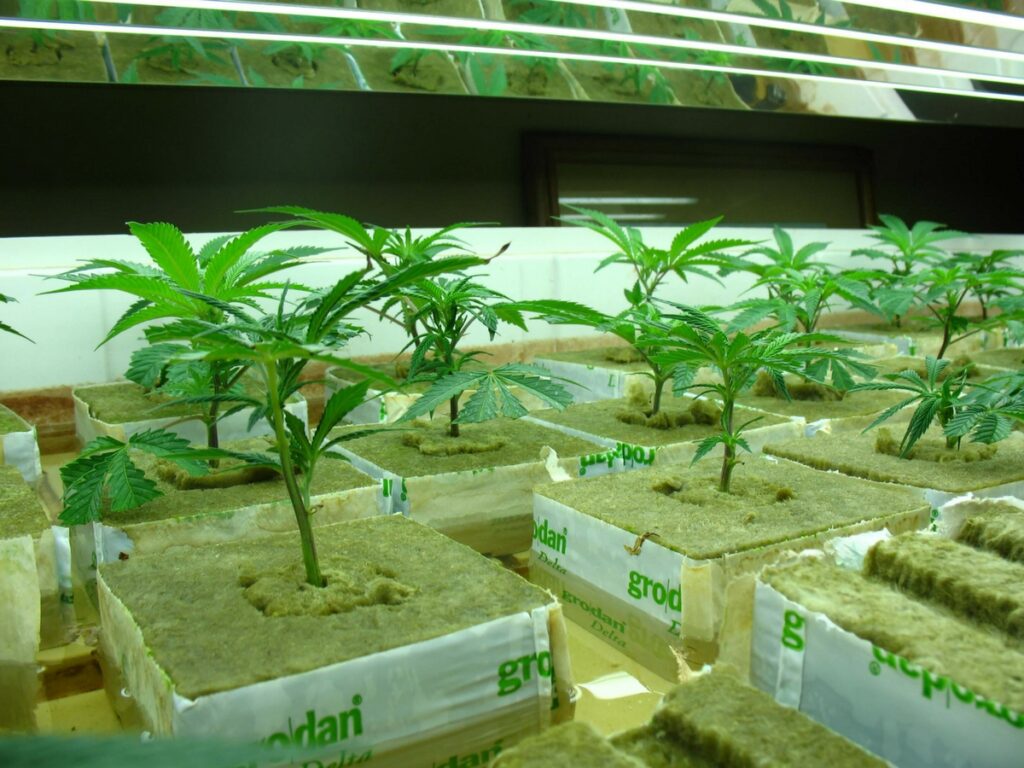
Diseases
An easily preventable form of disease is deficiency- or deprivation illness. The plants lack some necessary ingredient in their feeding. A shortage of iron produces yellowed (and falling) leaves. The pH value plays an important role in the prevention of deficiency disease. Keep the pH value around 5.8. If this value is too low, the plants can’t absorb calcium as well. Consequence: the osmotic processes are impeded. Too low a pH number causes less iron in-take, with the well- known results. A second form of deficiency disease is caused by a shortage of the primary nutrients (NPK). It often involves a lack of nitrogen (N). A nitrogen shortage delays growth, and makes the lower-most leaves turn yellow and drop off. Less often, we see a shortage of phosphate (P). With a phosphate shortage, the leaves turn deep green, and they remain small. Yellowing and dying lower leaves happen here, also. Potassium shortage (potassium is ‘K’) is another seldom-occurring problem. The noticeable feature is first the yellowing of the point of the leaf, after which the whole leaf turns yellow and brown, and dies off. A lack of potassium is more often caused by an acidic soil than by an actual potassium shortage. So, make sure to maintain an optimal pH! The remedy advised for these kinds of deprivation sicknesses: use NPK fertilizer. We don’t encounter deficiency disease as a consequence of a shortage of the secondary nutrients very often. This usually involves a lack of magnesium and/or calcium. It can usually be remedied by using an NPK mixture containing trace elements. The same counts for the micro-elements. We must make an exception for iron, since there is rarely too little iron. In that case, the pH value is usually too high. Molds can completely destroy a garden in a short time. If the climate in the grow room is well-controlled, molds, in general, have little chance. Molds and fungi thrive very well under humid conditions, preferably without much air circulation. Under these circumstances, mold spores, which are always present in the air, search for a spot to grow into mold cultures. If you don’t succeed in preventing mold growth, then you must do something about it as quickly as possible. With light mold growth, immediately remove the affected plant parts, and then create a climate in which cannabis does well, and molds don’t (good ventilation, control of humidity and temperature, and putting your plants on a medium which is not too wet). If there’s already too much mold present, you don’t have much choice but to spray with poison (fungicide). Repeat the treatment after a few days, even if you think the first application has definitely helped. Still,; improve climate control and growth conditions. Fungicide treatment should always be a last resort. It’s not healthy for young plants or people, so here, it’s also: ‘prevention is better than cure’ An often-occurring mold affecting cannabis is pythium. This mold causes root-rot, and rot in the lowest part of the stem. It appears most in young plants, and in cuttings. Larger, healthy plants are less sensitive to pythium. Plants get ‘falling-over disease’ with a serious pythium attack. We don’t have to explain what that means Pythium is recognizable by the bark at the base of the stem turning brown. In the beginning, the ‘brown attack’ is easily removable. Later, the rotting process eats deeper into the base of the plant. Pythium is a fungus which flourishes best in wet and humid environments. Pythium spores spread only through water. Two kinds of spores are formed; Swarming ones and stable ones. The swarming spores germinate best at a temperature of approximately 15 degrees Celsius, while the stable spores germinate if it’s relatively warm; around 28 degrees C. To prevent a pythium attack, a constant temperature of the soil or rockwool is needed. Large fluctuations in temperature should be avoided. Pythium can only be fought in a limited manner with chemicals. A proper relative humidity must also be maintained (not too high). Leaf molds, such as mildew, and thread molds occur less frequently than pythium. Mildew can cause tops to rot, among other things. Also here counts: ensure optimal climate control. Contrary to other molds, mildew flourishes well at a low relative humidity. Mildew can be more easily fought with chemicals, and fortunately, is not often found with cannabis. Rotting tops occurs the mainly at the end of the flowering phase. The more compact the plant, the bigger the chance for tops to rot. You can identify toprot by the sudden yellowing of the top-most leaves. These yellow leaves are fairly loose on the plant, and can be easily removed. To prevent the whole plant from being affected, you must, unfortunately, remove the whole top. The appearance of toprot can be prevented in some cases, by lowering the relative humidity during the dark period.

